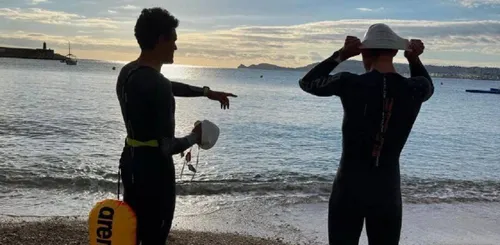“Having had a long career, I saw, or rather lived, the shift between Italy and Spain,” he said in an interview to bici.pro. “Until 2005 we went to Tuscany, and not just us, many foreign teams came too. I remember Telekom, Rabobank, Lotto and many French teams.”Many riders are known to live in Spain. One of them is Mathieu van der Poel, who lives in Alicante, and was recently seen swimming alongside Greg van Avermaet.
According to Tosatto, several factors played a role to cause this shift, mainly weather and infrastructure. “A little bit the climate changed, a little bit the need for another type of infrastructure. Meanwhile, Spain grew a lot and now almost everyone goes there, including us. I think within 50 kilometers of coastline between Valencia and Alicante you find all the teams in the world.”
“Over there in December, the temperature is still excellent and certainly the hotels are more structured,” he added. “They have gyms, spacious parking for vehicles, meeting rooms to do many things. On the internal roads there is also much less traffic, another important factor.”
The economics cannot be ignored either. “In Spain they make excellent prices for cyclists. Sometimes I went alone for specific work and I remember it was really very convenient.”
Tosatto places the transition in the mid-2000s and praises the Canary Islands as the best place for cyclists to prepare for the upcoming season. “With Quick Step in 2006 we did the December camp in Italy and then the January one in Calpe. Then from 2008 onwards we went only to Spain, to Gran Canaria. In my opinion, that is the best place of all, it’s always between 18 and 26 degrees, and you can do everything. Long climbs, short climbs, flat roads, everything you need to train well.”
Why not Italy anymore?
Some have suggested southern Italy (and especially Sicily) as an alternative. Tosatto has doubts. “I was in Sicily for a week in 2015, and we were under Mount Etna. The climate was excellent, it was good, but I remember the problem was the roads. The main one was good, but the internal ones much less because of the traffic. There were also many stray dogs that can be a problem on the bike.”
Still, he praised the mountain itself. “The climb of Etna is the most beautiful landscape you could see, and you could train very well. But you cannot just go up and down that climb all the time.”

Will Mathieu van der Poel ever try triathlon?
Other Italian regions had potential to become pre-season hubs, but they just cannot compare to Spain. “Another time, always with Quick Step, we went to Puglia and it seemed like an excellent place. Both for climate and infrastructure. The problem is that there are no climbs, and now even in December teams already start doing quality work.”
Tosatto recalled that Italy once had a strong pull because of its food, but that is something that has changed with the rise of traveling team chefs. “Once people looked a lot at the quality of the cuisine, which in Italy is and remains unbeatable. I remember foreigners were amazed even just by a cappuccino, and even only for that they came to us very willingly.”
When asked about the memories of the best and worst training locations, Tosatto has clear answers. “For me the best place overall is Gran Canaria. We were there in the Bjarne Riis era, in a beautiful structure, a very large golf club where we had one villa for every three riders. Also for training quality, climate, a bit of everything.”
And the least pleasant? “Perhaps in 2013, when in January we went to Corsica for a week to see the first stages of the Tour that started from there. The place was very beautiful, but we had five days of rain and wind, and with Riis you trained always and no matter what.”
From a purely technical perspective, Tosatto argues that methodology has not dramatically changed compared to some years ago. “In my opinion it hasn’t changed that much compared to fifteen years ago. The first camp, the one in December, is when everyone comes together and it’s used to build the group, because it’s the only time of year when truly everyone is there, from athletes to staff.”
“You train more endurance, without too much intensity,” he continued. “Instead, the second one, in January, is more specific in terms of workload, and the different groups are already formed, for example those who race soon in Australia.”
Eyes already on the springLooking toward 2026, Tosatto confirmed Tudor will target the full block of spring classics. “In general we aim to do well in all the Classics starting from Milano-Sanremo, especially since we strengthened ourselves with quality riders like Stefan Küng and Luca Mozzato. And in 2026 we will be present at all WorldTour races and we want to do well also at Amstel and Liège with Alaphilippe and Hirschi.”
“If I really had to pick two races that are right for us, though, I’d say Flanders and Roubaix are our two big spring goals . I’m sure we have the team to do very well,” he concluded.

